Hinge
A hinge is a mechanical bearing that connects two solid objects, typically allowing only a limited angle of rotation between them. Two objects connected by an ideal hinge rotate relative to each other about a fixed axis of rotation: all other translations or rotations being prevented, and thus a hinge has one degree of freedom. Hinges may be made of flexible material or of moving components. In biology, many joints function as hinges like the elbow joint.
Door hinges
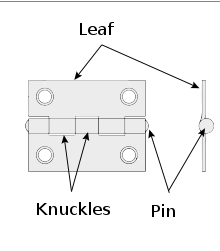
- Barrel hinge
- A barrel hinge consists of a sectional barrel (the knuckle) secured by a pivot. A barrel is simply a hollow cylinder. The vast majority of hinges operate on the barrel principle.
- Butt hinge / Mortise hinge
- Any hinge which is designed to be set into a door frame and/ or door is considered to be a butt hinge or a mortise hinge. A hinge can also be made as a half-mortise, in which case only one half of the hinge is mortised and the other is not. Most mortise hinges are also barrel hinges but virtue of how they pivot (i.e., a pair of leaves secured to each other by knuckles through which runs a pin).
- Butterfly/ Parliament (UK) hinge
- These are a decorative variety of barrel hinge with leaves somewhat resembling the wings of a butterfly
- Case hinges
- Case hinges are similar to a butt hinge however usually more of a decorative nature most commonly used in suitcases, briefcases and the like.
- Concealed hinge
- These are used for furniture doors (with or without self-closing feature, and with or without damping systems). They are made of two parts: One part is the hinge cup and the arm, the other part is the mounting plate. Also called "cup hinge", or "Euro hinge", as they were developed in Europe and use metric installation standards. Most such concealed hinges offer the advantage of full in situ adjustability for standoff distance from the cabinet face as well as pitch and roll by means of two screws on each hinge.
- Continuous/ Piano hinge
- This variety of barrel hinge runs the entire length of a door, panel, box., etc. Continuous hinges are manufactured with or without holes.
- Flag hinge
- these consist of a single leaf attached (in the male variety) to a pin. When used, the pin is inserted into the other (female) portion of the hinge. This allows the objects to be easily removed from e(for example, a removable door). They are manufactured in right-hand and a left-hand configurations.
- H hinge
- These barrel hinges are shaped like an H and used on flush-mounted doors. Small H hinges (3–4 in or 76–102 mm) tend to be used for cabinets hinges, while larger hinges (6–7 in or 150–180 mm) are for passage doors or closet doors.
- HL hinge
- These were common for passage doors, room doors and closet doors in the 17th, 18th and even 19th centuries. On taller doors H hinges were occasionally used in the middle along with the HL hinges.
- Pivot hinge
- This hinge pivots in openings in the floor and the top of the door frame. Also referred to as a double-acting floor hinge. This type is found in ancient dry stone buildings and rarely in old wooden buildings. These are also called haar-hung doors. They are a low cost alternative for use with light weight doors.[1]
- Self closing hinge
- This is a spring-loaded hinge with speed control function. The same as spring hinge, use spring to provide force to close the door and provide a mechanical or hydraulic damper to control door close speed. That can prevent door slamming problem while auto closes a door.[2]
- Spring hinge
- This is a spring-loaded hinge made to provide assistance in the closing or the opening of the hinge leaves. A spring is a component of a hinge, that applies force to secure a hinge closed or keep a hinge opened.[3]
- Living hinge
- This hinge takes advantage of the flexibility of plastic to create a join between two objects without any knuckles or pins. They are molded as a single piece, never become rusted, do not squeak, and have several other advantages over other hinges, but the plastic makes them more susceptible to breakage.
Other types include:
- Coach hinge
- Counterflap hinge
- Cranked hinge or storm-proof hinge
- Double action non-spring
- Double action spring hinge
- Flush hinge
- Friction hinge
- Lift-off hinge
- Pinge: A hinge with a quick release pin.
- Rising butt hinge
- Security hinge
- Tee hinge
Building access
Since at least medieval times there have been hinges to draw bridges for defensive purposes for fortified buildings. Hinges are used in contemporary architecture where building settlement can be expected over the life of the building. For example, the Dakin Building in Brisbane, California, was designed with its entrance ramp on a large hinge to allow settlement of the building built on piles over bay mud. This device was effective until October 2006, when it was replaced due to damage and excessive ramp slope.
Large structures
Hinges appear in large structures such as elevated freeway and railroad viaducts. These are included to reduce or eliminate the transfer of bending stresses between structural components, typically in an effort to reduce sensitivity to earthquakes. The primary reason for using a hinge, rather than a simpler device such as a slide, is to prevent the separation of adjacent components. When no bending stresses are transmitted across the hinge it is called a zero moment hinge.
Spacecraft
People have developed a variety of self-actuating, self-locking hinge designs for spacecraft deployable structures such as solar array panels, synthetic aperture radar antennas, booms, radiators, etc.[4]
Hinge terminology
Components
- Pin
- The rod that holds the leaves together, inside the knuckle. Also known as a pintle.
- Knuckle
- The hollow—typically circular—portion creating the joint of the hinge through which the pin is set. The knuckles of either leaf typically alternate and interlock with the pin passing through all of them. (aka. loop, joint, node or curl)
- Leaf
- The portions (typically two) that extend laterally from the knuckle and typically revolve around the pin.
Characteristics
- End play
- Axial movement between the leaves along the axis of the pin. This motion allows the leaves to rotate without binding and is determined by the typical distance between knuckles (knuckle gap) when both edges of the leaves are aligned.
- Gauge
- Thickness of the leaves.
- Hinge width
- Length from the outer edge of one leaf to the outer edge of the other leaf, perpendicularly across the pin (aka open width).
- Hinge length
- The length of the leaves parallel to the pin.
- Knuckle length
- The typical length of an individual knuckle parallel to the pin.
- Leaf width
- Length from the center of the pin to the outer edge of the leaf.
- Pitch
- Distance from the end of a knuckle to the same edge of its adjacent knuckle on the same leaf
- Slop
- A colloquialism referring to loose angular movement of the leaves relative to the pin.[5]
Other types
- Butler tray hinge
- Folds to 90 degrees and also snaps flat. They are for tables that have a tray top for serving.
- Carpentier joint
- A hinge consisting of several thin metal strips of curved cross section.
- Card table hinge
- Mortised into edge of antique or reproduction card tables and allow the top to fold onto itself.
- Drop-leaf table hinge
- Mounted under the surface of a table with leaves that drop down. They are most commonly used with rule joints.
- Hinged handcuffs
- a restraint device designed to secure an individual's wrists in proximity to each other consisting of two cuffs linked with a double or triple hinge. Hinged handcuffs cuffs tend to restrict movement more than chain-linked handcuffs, and they can be used to generate more leverage to force a suspect's hands behind the back, or to apply pain against the wrist, forcing the subject to comply and stop resisting.[6]
- Piano hinge
- a long hinge, originally used for piano lids, but now used in many other applications where a long hinge is needed.
- Living hinge
- a hinge consisting of material that flexes
Gallery
 Old construction of hinges in the dry stone wall near Bignasco.
Old construction of hinges in the dry stone wall near Bignasco.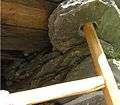 Ancient pivot hinges, found in the dry stone buildings.
Ancient pivot hinges, found in the dry stone buildings.- A flushed door hinge.
 A barrel hinge made of wrought iron.
A barrel hinge made of wrought iron. A barrel hinge made of bronze strap.
A barrel hinge made of bronze strap. Increasing the number of loops to 3 allows the butt hinge axis to be fixed from both ends.
Increasing the number of loops to 3 allows the butt hinge axis to be fixed from both ends.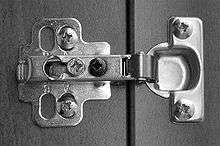 Door in furniture with spring to lock door both fully shut and fully open positions. It hides completely behind the door and has adjustment for fine alignment. Allows the door to open even when against a wall.
Door in furniture with spring to lock door both fully shut and fully open positions. It hides completely behind the door and has adjustment for fine alignment. Allows the door to open even when against a wall. Rusty hinges on a building exterior.
Rusty hinges on a building exterior.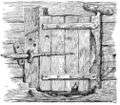 This door hinges on the stile and is called a haar-hung door.
This door hinges on the stile and is called a haar-hung door.- A living hinge on the lid of a Tic Tac box.
 Hinged handcuffs
Hinged handcuffs A strap hinge.
A strap hinge.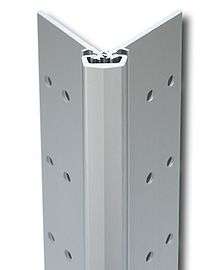 A continuous hinge.
A continuous hinge.
See also
- Hinge bender, a tool for adjusting hinges
- Concealed hinge jig – Support and locating tool for drilling recess holes to mount concealed hinges
- Floating hinge – Type of hinge that allows rotation and some linear movement
- Geared continuous hinge – A type of continuous hinge used mostly on doors in high-traffic entrances
- Plain bearing – Simplest type of bearing, comprising just a bearing surface and no rolling elements
References
- "Pivot Hinges". Guden. Retrieved 15 December 2016.
- "Self closing hinge". ChihaoH. Retrieved 27 May 2019.
- "Spring Hinges". Guden. Retrieved 15 December 2016.
- Alan M. Watt; and Sergio Pellegrino. "Tape-Spring Rolling Hinges" p. 2.
- heyok (28 April 2014). "Jeep JK tail gate hinge slop" – via YouTube.
- "On the Job: Lifesaving Handcuffing Tactics". 30 December 2014.
External links
| Look up hinge in Wiktionary, the free dictionary. |
| Wikimedia Commons has media related to Hinge. |
- Hinge Terminology—Hingecraft; graphics visualizing many terms
- Guden Hinges and Industrial Hardware: Glossary